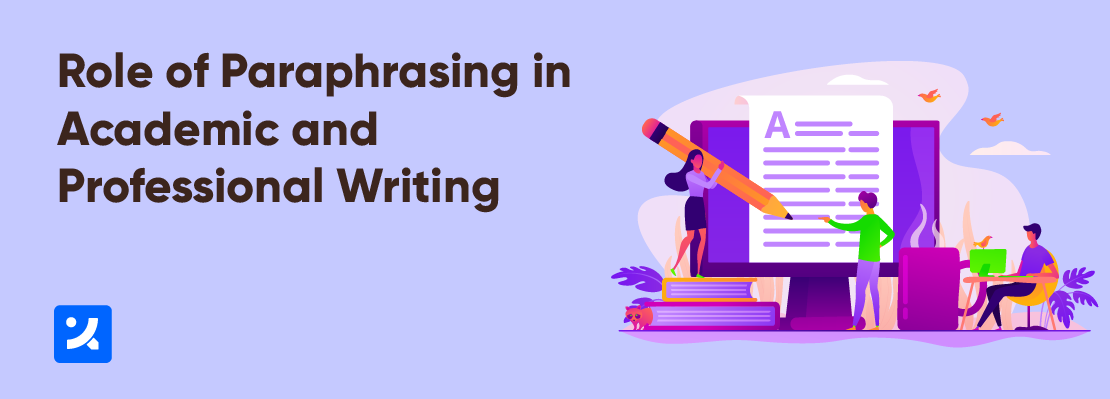
Writing is one of the most adaptable fields, with applications in various areas. Two of the most popular ones are the academic and professional sectors. However, to excel in these industries through writing, a writer must be proficient in various writing approaches, including paraphrasing.
Paraphrasing is valuable for every writer, regardless of their niche expertise. Due to its connection with writing, this skill set applies to both academic and professional writing domains. If you want to know, this blog has you covered.
In this blog, we’ll discuss the role of paraphrasing in academic and professional writing and how this skill set can help you succeed in these fields.
Paraphrasing — A Bird’s-Eye View to This Concept
Paraphrasing is a fancy term for using your words to communicate pre-existing ideas. However, for this writing technique to be effective, the paraphrased content must communicate the same idea. Otherwise, the information will be regarded as poor or incorrectly paraphrased.
What Part Does Paraphrasing Play in Academic and Professional Writing?
Paraphrasing is vital for success in both academic and professional writing. Here’s how this writing method works in various sectors:
Improves Understanding of the Source Text
Successful paraphrasing necessitates a more in-depth understanding of the source material. You can’t just skim through the surface. Instead, you must have a deeper understanding of the source to paraphrase the text effectively. With this practice, you can explain even the most complicated subjects in your own words, which will be a helpful talent in any writing-related field.
Helps Avoid Content Plagiarism and Duplication Issues
Plagiarism is a severe problem in all writing-related fields, including academic and professional. However, paraphrasing the content is the best way to address this problem. When paraphrasing a piece of text, experts generally use various writing techniques, including synonym replacement, sentence restructuring, and word reordering. Combining these strategies can make your write-ups appear distinctive and your content will easily pass the detection test of an advanced plagiarism checker.
Pro Tip: Always give credit to the original author of any content you paraphrase. If not, your paraphrased material will be regarded as a violation of academic integrity, regardless of its uniqueness.
Encourages Creativity and Critical Thinking
Sometimes, the source text contains a lot of fluff. So, if you want to paraphrase such a content piece, you will have to differentiate between the essential core concepts and unnecessary details. This assessment needs careful consideration and critical thinking. So, paraphrasing a text piece can improve your critical thinking and creativity.
Enhances Writing Quality
One significant hidden meaning in the definition of paraphrasing is that it improves the clarity of the source content. So, if you have a text piece with long phrases and complex information, you can paraphrase it to improve its quality. For example, you can convey the same information using short and simple-to-understand words. Doing so will enhance the readability of your content. Hence, paraphrasing allows authors to express information more clearly and increase the readability of their text.
Some Tips of the Trade for Effective Paraphrasing
You may have gained knowledge about the role of paraphrasing in the professional and academic spheres by now. However, this skill set will only benefit your writing if you use it properly. So, use the methods below to paraphrase any kind of text successfully:
Don’t Start Without Understanding the Source Text
You can only express something in your own words if you fully comprehend it. So, before paraphrasing a text piece, be sure you completely understand it. If not, you’ll need to read the source material more carefully.
Try a Combination of Writing Techniques
When writing the paraphrased version, employ a variety of strategies. For example, you can use synonym substitution, phrase restructuring, and rewording tactics to build your own version of the source text. However, while doing so, do not look at the original version. Otherwise, you will unintentionally plagiarize your work.
Compare the Paraphrased Version With the Original Variant
Once you’ve completely paraphrased your content, compare it to the source text. If it appears unique or original, you’re good to go. But if that is not the case, we propose reimplementing the abovementioned suggestions. By adopting this method, you can reduce the risk of accidental plagiarism.
Take Assistance from a Paraphrasing Tool
Let’s say you have attempted to paraphrase your information but have not yet succeeded. So, if that’s the case, consider using a paraphrasing tool. Through modern algorithms, like Natural Language Processing and ML models, such a utility can paraphrase text like humans.
Wrapping Up — Final Verdict
In conclusion, paraphrasing is a valuable skill set for academicians and professionals. It entails restating an existing material to communicate the desired meaning without replicating the original language. This writing technique is essential because it allows people to communicate their ideas creatively and coherently while avoiding plagiarism and maintaining integrity. However, this can only be accomplished by mastering the art of paraphrasing. So, make sure you clearly understand the source text.
